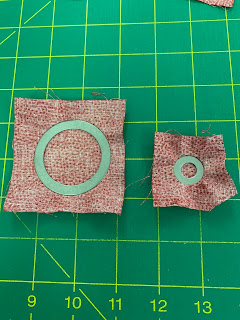For those working on Double 9 Patch blocks, those continue this month too. I gave important cutting info about the Double 9 Patches when we released Month 6 early, in March, so if you haven't started them yet, be sure to take a look at that post: Double 9 Patches. Remember, there are 64 Double 9 Patches in the quilt.
Both of the applique blocks this month feature circles. Recently, I learned about a new product, Applipops. They are metal disks that fit together, making it very easy to create round circles.
Take a look at their short video from the website to see the process: Applipops Video
I got 2 Pro Packs so I could try them out and used them with the 3 different size circles needed this month.
UPDATE--Applipops has a discount for YOU--use BARBSFRIEND as a discount code to get 10% off your order.
The process is very easy. The instructions say to use undiluted liquid starch and I should have. I had a 50/50 starch/water mix in a small spray bottle so used that. The edges would have been stuck down better with straight liquid starch.
First step: cut a hunk of fabric and place it between two disks:
Trim to about a 1/4" seam allowance, less on very small circles. On the largest circle, I left too much seam allowance so the edges have a few little puckers on the back.
If I were hand-appliqueing these, I could easily smooth out the little puckers:
Note I sprayed this red fabric on a washcloth as I just recently changed my big ironing board cover and knew the red might run--it clearly did:
The only down side I can see is you have to wait for the metal disks to cool before handling them, and the starch to dry before removing the disks. With two sets I can make two of each size at the same time. Since I didn't need a lot of circles, that was OK. If you need to make 20 of the same size, at the same time, it might take a while.
My usual method of making small circles is with Karen Buckley's Perfect Circles, sets of Mylar circles. That method requires basting around the template. If making a lot, that would take some time. On the Forum recently, someone posted she machine basted instead of hand basted and I thought that was brilliant! You can't go fast but it would still be faster than hand-basting. See Karen demo her process on Show 2007
Be sure to look at the Forum to see some of the fabrics being used by our members. Also, some people are choosing to change from an On-Point set to a Straight Set. Forum--Show and Tell Your Blocks
This month's blocks on my sample quilt:
 |
| Block 23 |
 |
| Block 24 |
Let's quilt,
Barbara






I love using the KKB Perfect Circles but never thought of basting by machine--great idea! I have been planning to do my blocks in a straight set also--I prefer the diagonal lines created by the double nine patches.
ReplyDeleteI too am a fan of KKB's Perfect Circles. I don't mind the hand-basting. It's good TV-watching work!
ReplyDeleteI’m glad you’ve discovered Applipops! I’ve had mine for a month or so now and love them. And don’t forget that you can use either a gluestick or school glue instead of starch. A bit faster I think and so easy to smooth out those little points and imperfections before you release it.
ReplyDeleteI saw and shared that video on my Facebook. I will add it to the blog too—looks really fast.
DeleteYou can use spray starch. Spray a small amount in the lid and use your small brush to apply to the edges of your applique pieces. Left-over is easily rinsed out of lid. Aren't you concerned about red bleeding on the background later if it bleed now?
ReplyDeleteI don’t always pre-wash but always wash quilts with Color Catchers. That usually works.
Delete